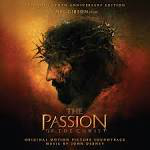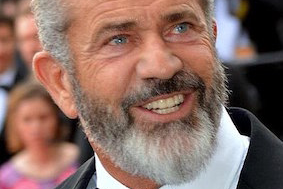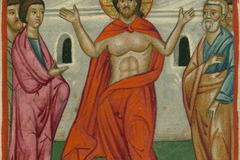A Catholic analysis of Mel Gibson's 'The Passion'

First published LONDON - 12 November 2003 - 3,100 words
The Passion of Christ is a considerable cinematic achievement.
BACKGROUND
The Passion is scheduled for release on Ash Wednesday, 25 February 2004 - but for the past year there has been worldwide discussion and controversy about the film. This has been based on apprehensions about how the film would be made, as well as on sensitivities about Jewish-Christian history, anti-Semitism and current dialogue between Judaism and the Churches, especially in the United States. Some of the discussion, held on a high level, especially among theologians, biblical scholars and religious leaders was based on reports of initial drafts of the film.
The Passion of Christ has been a long-cherished project of actor-director, Mel Gibson. His Catholic affiliation and support of traditional Catholicism was another controversial factor in the discussions. Early screenings of The Passion as a work in progress offered opportunities for Church leaders and Christians involved in media to see the actual film, offer their opinions and dialogue with Mel Gibson.
There seemed to be a general consensus that it was not anti-Semitic. Some Jewish leaders and reviewers like Michael Medved spoke positively about the film. Several heads of Vatican offices saw a show-reel of the film and spoke positively, including Archbishop John Foley, head of the Pontifical Council for Social Communications and Cardinal Dario Castrillon of the Congregation for the Clergy who issued a statement urging all priests to see the film.
Cardinal Walter Kasper received comments from Jewish leaders and issued a statement that the Vatican at large was not recommending the film and that any recommendation would depend on people seeing the completed film. This was the stance of many religious leaders in the United States including the American Bishops Catholic Conference. As regards the Jewish-Christian issues and the explicit language about the Jews in the Gospels, especially that of St John, it is important to realise that the more formal, 'official' antagonism between Christians and Jews emerged in the early decades of the second century. The Gospels of Matthew, Mark and John emerged from Jewish communities. Luke's Gospel draws strongly on the Jewish scriptures interweaving biblical references and motifs throughout the text.
The clash between Jesus and the religious leaders of his time was a clash within Judaism, a religious controversy about the Messiah (of which there were a number in this period) and Jesus' claims. Disciples who became Christians accepted his claims. Many religious leaders amongst the priests and the pharisees did not. There were other converts like Paul, who was proud of his Jewish heritage and who took a strong stance about disciples of Jesus not being bound by details of Jewish law. It has been difficult, given the centuries of antagonism and the experience of repression and persecution of Jews by Christian, and Catholic, communities to enter into the context of Jesus' time and the mentality of the period.
The long traditions of Christians accusing Jews of being 'Christ-killers' also played their part in the debate. While the Catholic Church apologised for the persecutions and frequent anti-Semitism of the past in a Second Vatican Council document (1965) and Pope John Paul II visited the wailing wall in 2000 and inserted his own prayer in a crevice, questions about Jesus' death as being part of God's plan and how the Jewish religious leaders of the time and the Romans, with Pontius Pilate, fitted into this plan, continue to be raised. I received an invitation to see the film at the Icon offices in Santa Monica (Mel Gibson's Los Angeles production headquarters) on October 24th, 2003. The version we saw was still a work in progress. More work had to be done on special effects and on the sound track. Mel Gibson met with me briefly after the screening and I was able to have some discussion with him about the film. My attitude towards the film was very positive.
BIBLICAL BACKGROUND
The Passion draws its narrative from each of the four Gospels, for instance, the quake and the rending of the temple from Matthew, the fleeing young man from Mark, the women of Jerusalem (here, Veronica and her daughter) from Luke, the Pilate sequences on truth from John. This linking of incidents in one narrative is the way in which the Gospel stories were remembered and written down. There is some material drawn from the later legendary stories and apocryphal gospels (Veronica and her veil, Desmes the 'bad' thief). One of the difficulties that films of the life of Jesus encounter, especially from scholars and theologians not versed in the techniques and conventions of cinematic storytelling, is that they sometimes tend to be critiqued and judged as if they were actual Gospels. They are found wanting at this level and dismissed or condemned. This is a danger for The Passion. It needs to be reiterated that this is a film and that the screenplay is a 'version' of the Gospel stories with no claim to be a Gospel.
This use of the four Gospels means that there are different perspectives on the Jews of the time in each Gospel. Matthew's Gospel presupposes detailed knowledge of the Jewish scriptures and sees Jesus as the fulfilment of prophecy. Hence the more 'apocalyptic' scenes at his death. Mark and Luke look on from the outside, Luke writing for readers familiar with Greek and Roman ways of storytelling. John's Gospel from the end of the first century echoes the roots of Christianity in Judaism but acknowledges the growing rift.
The screenplay is able to combine Gospel incidents into a coherent narrative of the passion with selected flashbacks to Jesus' infancy and life in Nazareth (his fall as a child, his making a table in the carpenter's shop, his relationship with his mother and his playful sprinkling her with water as he washes his hands) which are inventions in the spirit of the Gospels, to Mary Magdalene's past where she is combined with the woman taken in adultery of John 8, to Peter and his protests of loyalty, to the Last Supper. There is a flashback to the palm welcome of Jesus to Jerusalem during the heckling of the crowd on the way to Calvary. There is dramatic development of characters like Pilate and his wife, Simon of Cyrene, the centurion, the good thief and the thief who reviles Jesus (with retribution seen in the form of a vicious crow attacking him).
Of interest is the portrait of the Satan, the Tempter, who appears early as an androgynous character, visual suggestions of female but male voice, growing more obviously feminine as the film progresses and finally appearing at the crucifixion (with a visual technique reminiscent of William Wallace seeing his loved one at his execution) carrying a child. Once again, this is imaginative license in interpreting Jesus' being tempted and tested. As with most Jesus films, much attention is given to Judas. His motivations are not made explicit in the film. It relies on audience knowledge of Judas. The film portrays his action in Gethsemane and subsequent dismay and return of his thirty pieces of silver. It introduces a theme of children meeting Judas and taunting him as he goes to his death.
THEOLOGICAL BACKGROUND
The principal theological issues that concern viewers of Jesus-films are: 1. The humanity and divinity of Jesus, 2. The Resurrection of Jesus The humanity and divinity of Jesus. The Passion of Christ generally follows the approach to the person of Jesus used by the Synoptic Gospels, a 'low' Christology, a focus first on the humanity of Jesus and moving towards an awareness of his divinity. When the film uses John as a source, it reflects that Gospel's 'high' Christology, the presupposition in the narrative that Jesus is divine and expresses this divinity in word and action.
The Synoptic approach is seen in the flashbacks of incidents before the Passion as well as in the main events of the Passion, the Agony in Gethsemane, the treatment of Jesus by the Sanhedrin and Herod, the scourging and crowning with thorns, the way of the Cross and the Crucifixion itself.
The Joannine approach is found in Jesus' declaration of his being the Son of Man at his trial (which is also in the Synoptics) and the discussions with Pilate about truth and about his kingdom. This means that, theologically, the film presents the perennial teaching that Jesus, in his person, was both human and divine in nature. The humanity of Jesus is often presented in a striking manner: Jesus working in Nazareth, the experience of deep human pain in his agony, scourging, falling on the way to Calvary, the nailing and his experience on the cross. It is there in his dignity at his trial, his composure with Pilate and Herod. The film also highlights Jesus' human anguish of soul and sense of abandonment in his agony and on the cross, along with his profound surrender to the Father. While the Jesus of cinema is usually slight and slender in build, Jim Caviezel is a big and strong man, with some girth, a credible carpenter and a solid man. This makes the film's Jesus more real than usual.
The Resurrection
Some commentators criticise a film which focusses on the Passion for its meagre treatment of Jesus' resurrection. (This was a criticism in the 1960s and 1970s of Jesus Christ Superstar.) Theologically, the Passion makes sense only in the light of the resurrection. While Mel Gibson's film wants to immerse its audience in the experience of the Passion, the final sequence has the stone rolled over the tomb. The stone is rolled away, the cloths wound around Jesus' body are seen collapsing and the camera tracks to Jesus in profile, sitting in the tomb as a prelude to his risen life. These are the images with which the audience leaves the theatre.
The Resurrection, presented briefly, is still the climax of the Passion. The Eucharist There are flashbacks to the Last Supper during the Passion, especially to Peter protesting that he would not deny Jesus and to Jesus washing the disciples' feet. One of the major theological strengths of the film is the insertion of the Eucharistic scenes of the Last Supper during the nailing and the lifting up of Jesus on the cross. As Jesus offers the bread as his body, we see the body which is painfully broken and given for us. As he offers the wine as his blood, we are only too conscious of the bloodletting, blood poured out for us. Jesus tells his disciples that there is no greater love than laying down one's life for friends - and we see it in its fullness. He tells them to celebrate the Eucharist so that his passion and death will be present to them. In this way, the screenplay highlights both aspects of the Eucharist, the celebration of the meal, the communion and the sacrifice of Jesus.
Mary has a strong presence in The Passion. She appears as a woman in her 40s, striking rather than beautiful. She appears in two flashbacks. Her demeanour is serious. She says very little. With Mary Magdalene and John, she follows the passion and the way of the Cross without any of the histrionics that characterise a number of portraits of Mary, especially Pasolini's mother in The Gospel According to Matthew. At one stage, she wipes the blood of Jesus on the praetorium floor after his scourging. She kisses his bloody nailed feet. The bond between mother and son is suggested several times by significant eye contact rather than words. The request for John to take care of Mary is included. After Jesus is taken down from the cross, she holds him in a Pieta tableau. Most audiences should be satisfied with the portrayal. Those who find some of the cinema representations of the past too much like holy cards or plaster statues will appreciate a more biblically-grounded Mary. Cinema background The Passion of Christ comes after more than a century's old tradition of Jesus' films. The silent era produced short instructional films as well as features like From the Manger to the Cross, the Italian Christus and the Gospel section of DW Griffith's Intolerance.
The major films of the 20s were Ben Hur and The King of Kings, Cecil B. de Mille's epic. For 35 years, 1927-1961, Jesus was not seen face-on as a character in American studio Gospel films. He was seen in a number of features made by American Protestant companies. He was glimpsed in part (a hand, an arm, his legs on the cross or was seen from a distance) in films as The Robe and Ben Hur in the 1950s.
After the gap, Jeffrey Hunter appeared as the King of Kings, Max Von Sydow in The Greatest Story Ever Told. When Jeffrey Hunter spoke in King of Kings, it was the first time audiences had heard an actor speak the words of Jesus.
Pasolini made a powerful black and white version in the 1960s, The Gospel According to Matthew, and Rosselini made The Messiah in the early 1970s. Brian Deacon appeared as Jesus, a more evangelical approach in the film, Jesus (which was distributed in an edited version to pilgrims visiting Rome for the millennial Jubilee). This trend reached its peak with Zeffirelli's Jesus of Nazareth in the late 1970s.
Popular musical movements of the late 60s produced Jesus Christ Superstar and Godspell which were both filmed in 1973. Most of the films aimed at presenting a 'realistic' Jesus but many of them (including Pasolini) used the straight Gospel texts (which were intended to be read) as a substantial part of their screenplays, an over-literal use of the Gospels. Zeffirelli, on the other hand, employed the same method as was used in the forming of the Gospels, taking incidents in Jesus' life and combining them dramatically to make an impact on the audience. Nevertheless, with the use of western actors, European or American locations, these films were not as realistic as intended.
The musicals highlighted how screen Gospel storytelling is more 'stylised' than 'realistic'. Since 1988, there have been a number of screen portrayals of Jesus: The Last Temptation of Christ (1988), which was a 'novelised' version of the Gospels, Jesus of Montreal (1988) and Man Dancin' (2003) which were stories of putting on a passion play in a modern city, the animated Jesus in The Miracle Maker (2000) and Jeremy Sisto's engaging blend of the human and divine in the American telemovie, Jesus (1999).
More recently, there has been the rather American picture of Jesus in Paulist Film Production's telemovie, Jesus (2001, due for screening in 2004) and a more traditional Jesus in Philip Saville's The Gospel of John. It is in this tradition that The Passion comes to the screen. Mel Gibson had indicated his skills in directing with Man Without a Face (1993) and his Oscar-winning, Braveheart (1995). One of the principal intentions of the director and his co-screenwriter, Ben Fitzgerald, is to immerse audiences in the realism of the passion of Jesus. Actor Jim Caviezel was chosen to play Jesus (the only other name performer is Italy's Monica Bellucci as Mary Magdalene).
Caviezel was the same age as Jesus when the film was shot. As mentioned earlier, he is a believable human Jesus, a big, solid workingman who was able to stand up to the terrible sufferings of the passion before he died.
One of the controversial aspects of the film was the early decision to have the film's dialogue in Aramaic and Latin but to have no subtitles. The language decision was followed through and works well. We needed the subtitles, many of which are quotations from scripture. There is no distraction in hearing anachronistic American or British voices and accents. Rather the audience hears what conversation was like in those days. It is helpful to be reminded that Jesus spoke Aramaic and not English! A useful distinction to be made is that between 'realism' and 'naturalism'. The latter refers to film-making that portrays action as it is, home movies being a popular example, as is footage shot for newscasts. 'Realism' is film-making that helps audience have a genuine feel for what is going on on the screen, as if it were real.
A number of cinematic devices, such as the style of different compositions for the screen, the types of shots and the pace of the editing can be used to give this impression of realism. Mel Gibson has opted for much of his film to be 'naturalistic'. He has plenty of time available and is in no hurry to take us away from the picture of Jesus' suffering. Perhaps a number of people in the audience will find the scourging (in two grim parts) too much to watch. With most of the characters being portrayed in a naturalistic way, the action seems authentic. However, Gibson is able to use cinematic devices which alter perceptions, helping us to realise that we are seeing a particular version of the Passion, as all of us do when we listen to the Passion narratives and use our imaginations. He frequently uses moments of slow-motion filming to make us dwell on a particular moment. This naturalism is seen in the confrontation in Gethsemane, at Jesus' trial, with the scourging and the crowning with thorns and, especially, the way of the cross as Jesus struggles with the cross, falls with thudding impact, is nailed and the cross raised.
The stylisation is seen in the close-ups, with the differences in lighting (Gethsemane blue, the confined space of the High Priest's court lamplit, the broad daylight of the way of the cross), the framing of the characters with memories of the traditions of Christian painting, the lighting and some of the tableaux, the passing of time as Jesus hangs on the cross, his death and the apocalyptic aftermath, the intimations of the Resurrection. This offers a credible picture and understanding of Jesus. Gibson has introduced some effective elements to reinforce this. For instance, in the garden, Jesus is hit in the eye and from then on and during the trial, he has the use only of one eye; when he is able to open his injured eye, Gibson makes a great deal of his ability with eye-contact, with Pilate, with his mother and with John at the foot of the cross, simply looking at Jesus and nodding as he agrees to care for Mary.
Comment has already been made on the use and insertion of flashbacks. Dramatically, familiar Gospel characters are briefly developed which helps the narrative: Peter, Judas, Pilate, Pilate's wife, Simon of Cyrene, Herod, the two thieves crucified with Jesus. Veronica is introduced as she watches Jesus pass and wipes his face with her cloth - but Gibson shows restraint by letting us see her holding the cloth and, if we look closely, suggestions of the outline of Jesus' face can be glimpsed. The Roman soldiers are also vividly dramatised: the brutes a the scourging with their sadistic commander, the drunken soldiery mocking and brutalising Jesus along the way and on Calvary, the more sympathetic centurion. The key figure who has powerful dramatic impact in every Jesus' film is Judas. The taunting of the tormented Judas and the children pursuing him to his death is dramatically effective.
The Passion of Christ offers a credible, naturalistic Jesus whose sufferings of body and spirit are real. What impact it will ave on those who are not believers is very difficult to predict. For those who believe, there is the challenge of seeing pain and torture which are easier to read about than to see, but there is also the satisfaction of experiencing familiar Gospel stories in a different way.





















